Seltos takes Kia on its own compact-SUV road
By John Gilbert
The relationship between South Korean partners Kia and Hyundai has been interesting, if a bit confusing in the decade or so they’ve been united in a move by which Hyundai took in the struggling Kia operation. For awhile, it seemed that Kia simply got its own version of various Hyundai vehicles, but in recent years, Kia has boldly stepped out onto its own path.
There is no better example than the new Kia Seltos, a compact SUV that seems to be about the same size as Hyundai’s award-winning Kona. The Kona was named 2019 New Car Pick of the Year by newcarpicks.com, as well as numerous other evaluating sources. We are still evaluating our long-term Kona, which made it handy when a Neptune Blue 2021 Kia Seltos S Turbo showed up at our Duluth area home for a week’s test.
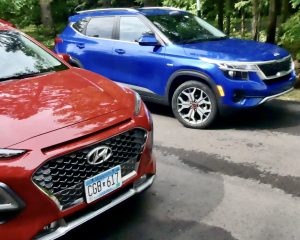
The Seltos is about 5 inches longer than the Hyundai Kona (left) and has more ground clearance, aimed for more rugged use.
Side-by-side, there are distinct differences, an objective the companies made a few years ago to use styling to differentiate, rather than copy. The Seltos is about 5 inches longer and about 2.5 inches taller, with those 2.5 inches used up by giving the Seltos about 7 inches of ground clearance, 2 more than the Kona.
The Seltos also has the unique Kia grille, under which is a very noticeable skid-plate, offering protection if you decide to do a little light off-roading.KWe were both impressed and puzzled by the Seltos S. Impressive was the sticker price, $26,740 with all options included, and also impressive was the Seltos S had a lot of punch from its 1.6-liter turbocharged 4 — the same engine that we got in the Kona. It has 175 horsepower at 6,000 RPMs, and a whopping 195 foot-pounds of torque at only 1,500 RPMs —a very good balance between the torque’s low-end punch and the horsepower’s cruising credits.
The all-wheel-drive system has a mode knob on the console, right next to the shift lever that governs the 7-speed dual-clutch automatic, and you can set it for normal, sport or eco. Enormously impressive is a switch that engages a downhill control, causing the engine to stay in a lower gear and aid you when descending hills without using only your brakes. In Duluth, where every avenue is a mile-high hill climb, meaning also a mile-down grade, that switch was eminently useful. The full array of safety gizmos are there, including a lane-departure system that includes lane-following, which keeps you centered in your lane, although not obtrusively.
With gadgetry like that, it seemed curious that the Seltos S did not have keyless entry, or keyless ignition, which mostly proves how spoiled we’ve become with all those push-button start systems. Still, for $26,000, the Seltos S seemed quite the bargain.
A few weeks later, we got a surprise visit from another Seltos, this one an SX Turbo, also with all-wheel drive, and also with the upgraded luxury features lacking on the Seltos S. It was Starbright Yellow, with black molding and trim, and it was striking. Different grille, departing from the Kia signature style, and LED lights all around. It also had the smart key, for entry and push-button start, and the interior upgrades were befitting the top line Seltos, priced at $29,485. Other additions were remote start, smart cruise control with automatic stop-start, a color instrument cluster, and 18-inch wheels, which were an option in the “S.”
The upgraded SX, in its bright yellow paint, didn’t have a sunroof, like its less-expensive sibling, and it had the same 1.6-liter turbo powertrain.
I made a call to James Bell, Kia’s director of corporate communications, and a trustworthy source of information of all things Kia, because he used to be a very good auto journalist, before he went over to the “dark” side. Asked about the similarities with the Hyundai Kona, Bell explained that there indeed were some.
“They are on the same platform, even though the Seltos is longer,” Bell explained. “The difference is that the Kona is a global car, and in Europe they like lighter, agile small SUVs. The Seltos is built specifically for the U.S. consumers, although it also will be sold in India, but not in Europe. It is aimed at being a little more rugged and capable. With the extra ground clearance, you could do light off-roading with it.”
On the road, we got 28.5 miles per gallon in combined city-highway driving, although when I realized we were mostly set in Sport, I switched it to the Smart normal setting and was able to get 32 mpg, which is very good for any SUV with all-wheel drive.
The Hyundai-Kia partnership also has a smaller SUV in the Hyundai Venue, while Kia’s counterpart to that, Bell said, is the Stonic, being sold in Europe.
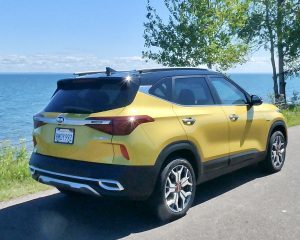
Seltos is roomy for five, and boasts hill-descent control, lockable axles for specific AWD situations, and mode control for ride variations..
Kia has also gone its own way with the Soul, which Hyundai doesn’t have but it has the Veloster, which Kia doesn’t have. The Kia Optima, a beautiful companion to Hyundai’s mainstream midsize Sonata, shares the matching restyling both have enjoyed for 2021, and the Optima will drop its name and become the K5, again going more aggressive with two turbo engines and an all-wheel-drive option.
Hyundai came out with the impressive Ioniq sedan, which can be had as hybrid, plug-in hybrid, or pure electric. Kia didn’t get that, but got the Niro, styled more like a compact SUV with an all-electric version that has nearly 300 miles of range on a charge.
“We think the demand for electric cars is only going to increase over the next couple of years,” Bell said. “As it is, we’re making all that we can make right now.”
It may be that by going their separate directions, Kia and Hyundai will expand their already elite level of market share. And the Seltos will be the light off-roader in the mix.


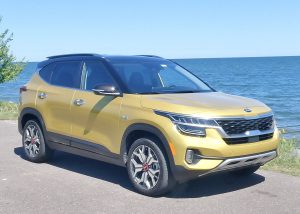
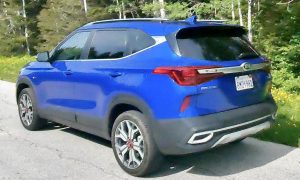
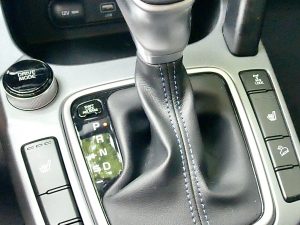
 John Gilbert is a lifetime Minnesotan and career journalist, specializing in cars and sports during and since spending 30 years at the Minneapolis Tribune, now the Star Tribune. More recently, he has continued translating the high-tech world of autos and sharing his passionate insights as a freelance writer/photographer/broadcaster. A member of the prestigious North American Car and Truck of the Year jury since 1993. John can be heard Monday-Friday from 9-11am on 610 KDAL(www.kdal610.com) on the "John Gilbert Show," and writes a column in the Duluth Reader.
John Gilbert is a lifetime Minnesotan and career journalist, specializing in cars and sports during and since spending 30 years at the Minneapolis Tribune, now the Star Tribune. More recently, he has continued translating the high-tech world of autos and sharing his passionate insights as a freelance writer/photographer/broadcaster. A member of the prestigious North American Car and Truck of the Year jury since 1993. John can be heard Monday-Friday from 9-11am on 610 KDAL(www.kdal610.com) on the "John Gilbert Show," and writes a column in the Duluth Reader.